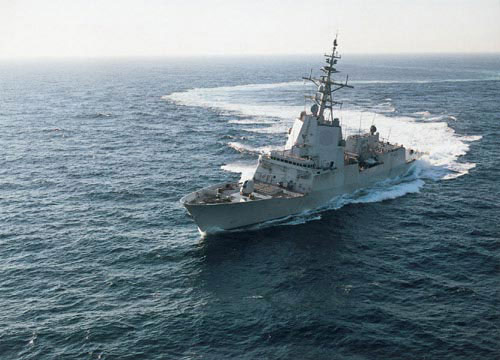July 15, 2008
More here, here, here and here.
This is probably a good idea.
The DDX/ DDG1000/ Zumwalt was conceived during the Clinton Administration as a "Land Attack Destroyer". The initial idea behind it was that it would be able to approach a third world shore due to a combination of stealth and general survivability and wreak havoc on the locals with long range guns firing precision guided shells. This is not a destroyer per say, this is in fact a monitor, the modern version of which was pioneered by the UK in WW1 (one example of which is left).
The Clinton administration liked the idea as it saw US forces operating in a variety of UN sanctioned peacekeeping roles. The gunfire support function seemed a valuable asset in any case and was seen as necessary given the imminent retirement of the Iowas. As a concept this was not without merit.
However, it was deemed prudent to give the vessel a general purpose capability so that it would not be useful only in the rare case of an amphibious landing. This again was not a bad idea, as the vessel was fleshed out it became apparent that it would be expensive and it seemed wasteful to pay through the nose for a ship rarely used.
There were a family of vessels planned under the moniker SC21, but only the land attack destroyer was proceeded with, which meant it had to be the next destroyer class as well.
So it had to have the next generation ...everything
next generation radar
the aforementioned gun...not an off the shelf weapon but a gun that would push naval artillery to the limit.
A new type of vertical launch system intended to allow the ship to survive the detonation of a missile magazine.
To save money...by reducing crew...next generation automation including little trams carrying little robots throughout the ship.
The ship had to survive inshore and the navy decided to make it stealthy.
A hullform was developed that prioritized stealth over seakeeping and damage control.
The vessel was intended to operate at a fixed displacement and always stay upright. According to Norman Friedman in his book on US Destroyers, this required huge and fast acting ballast tanks that, along with the automation, drove the ships size up considerably.
Increased size meant more places that were not full of stuff....so they got filled with stuff...expensive stuff.
Soon it was 14,000 tons...nearly the size of a predreadnaught battleship...oh and it was still supposed to be a stealth ship.
Against the backdrop of the surface of the ocean it is highly problamatioc that such a vessel can be made invisible to all radars, electo-optical, cosmic ray detectors, ultraviolet lenses, infrared, hydrophones, sonars, acoustic detectors, binoculars and the mark one eyeball.
An crude example of what I'm talking about....

The Bush administration did basically nothing to interfere with this dysfunctional development. Indeed, the original vertical firing "gun" was replaced with a more conventional trainable mount in the hopes that it could be used at short ranges if necessary and also fire standard 155mm shells to augment the expensive precision shells with existing stockpiles. Design changes and false economies in what became the Advanced Gun System ensured that not only could it not fire NATO standard 155 shells, but there is, as of right now, no real direct fire capability against ships.....thus the mechanically simpler vertical gun might have been the better choice.
Except for the 2 off the shelf (Swedish) 57mm guns, just about everything on the vessels is brand new, next generation and experimental. This is not to say that the stuff is useless or can't work, or that we should soldier on with 20th century tech, far from it...but it is likely a good idea to work the bugs out and assimilate lessons learned before building any more ships.
The US has had several testbed vessels that have advanced our naval technology, or shown that certain ideas are dead ends (see USS Vesuvius) and it is good to find these things out and work out the bugs before beginning a production run.
On the other hand...
While the whole US shipbuilding industry has experienced terrible cost and quality issues recently, I suspect that some of the obscene expense of these vessels is due to the fact that their cost includes a massive chunk of the current navy R&D budget.
I therefore suspect that whatever class is built with the developments of these systems will seem cheap as the development of said systems will have been paid for in the DDG 1000 budget.
Given that premise, I'm not sure that a tremendous monetary savings will be realized here, but some additional shipbuilding funds are likely to be freed up.
However, the current idea seems to be to build more DDG 51's (the Arliegh Burkes) and in the comments to this post at Gahlran's, back of the napkin calculations seem to indicate that this will result in 11 burkes for 5 DDG1000's.
Numbers are important. As one purpose of this blog is to comment above my paygrade, I would suggest building instead a larger number of the AFCON F-100's which are a joint Bath/Navitania design. They are very seaworthy, have full AEGIS capability, but all other systems are more austere. The Aussies have just selected this design as well.

This could greatly increase the number of frontline hulls available in a few years as older ships are decommissioned. It is a stopgap measure, but it has the potential to be an effective one.
UPDATE:
Another good use of any "found money" here would be to buy some of the canceled ASW modules for the LCS for tests.
Alternatively, more gator vessels like the LPDs or some logistics vessels might very well be a good investment. However, the big concern amongst many right now is the number of surface escorts that will be in service in a decade or so.
Posted by: The Brickmuppet at
10:02 PM
| Comments (2)
| Add Comment
Post contains 1024 words, total size 8 kb.
It sounds like the DDG-1000 was the Navy's equivalent of the Air Force's B2 and F22 programs.
I can't say I'm sorry to see plans to build more Burke's; those are fine ships. But we probably should also build something smaller and less capable just so we can get more hulls in the water. Sometimes there's just no substitute for quantity.
Posted by: Steven Den Beste at Tue Jul 15 22:25:17 2008 (+rSRq)
And just as I hit "post" I thought of something else. The DDG-1000 is also like the SeaWolf. In all five cases it's nice to see that Congress finally told DOD, "We don't care how good they are; not even the US can afford those things. Come up with something cheaper, even if it is less good and less survivable."
The Virginia's will be fine subs; we didn't need to build anymore SeaWolfs. The F-35 will be a fine jet; we don't need the F-22. More Burke's will be a better deal than the DDG-1000.
Posted by: Steven Den Beste at Tue Jul 15 22:28:06 2008 (+rSRq)
69 queries taking 0.1551 seconds, 182 records returned.
Powered by Minx 1.1.6c-pink.









